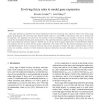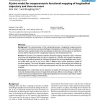420 search results - page 9 / 84 » Modeling Herds and Their Evolvements from Trajectory Data |
BIOSYSTEMS
2007
13 years 7 months ago
2007
This paper develops an algorithm that extracts explanatory rules from microarray data, which we treat as time series, using genetic programming (GP) and fuzzy logic. Reverse polis...
TIP
2010
13 years 2 months ago
2010
This paper proposes an approach for recognizing human activities (more specifically, pedestrian trajectories) in video sequences, in a surveillance context. A system for automatic ...
SPIN
1999
Springer
13 years 11 months ago
1999
Springer
One of the difficulties of using model checkers “in the large” is the management of all (generated) data during the validation trajectory. It is important that the results obta...
BMCBI
2006
13 years 7 months ago
2006
Background: The characterization of the relationship between a longitudinal response process and a time-to-event has been a pressing challenge in biostatistical research. This has...
ESANN
2006
13 years 9 months ago
2006
We explore the capability of the Self Organizing Map for structured data (SOM-SD) to compress continuous time data recorded from a kinematic tree, which can represent a robot or an...


